#Orange stonecrop
Video
n43_w1150 by Biodiversity Heritage Library
Via Flickr:
The botanic garden ;. London :Simpkin & Marshall,1825-. biodiversitylibrary.org/page/52546253
#Botany#Floriculture#Flowers#Great Britain#Pictorial works#Harvard University Botany Libraries#bhl:page=52546253#dc:identifier=https://biodiversitylibrary.org/page/52546253#flickr#papaver amoenum#heliophila trifida#sedum kamtschatka#pelargonium tricolor#Heliophila#Papaver somniferum#opium poppy#breadseed poppy#poppy#Orange stonecrop#stonecrop#Phedimus kamtschaticus#Pelargonium#geraniums#storksbills#botanical illustration#scientific illustration
6 notes
·
View notes
Text
Pathway Landscape in Chicago

Inspiring images for a sizable traditional shaded backyard stone garden path in the spring.
#weigela#orange stonecrop#dragon's blood sedum#pachysandra#sedum kamtschaticum#boxwood#flagstone stepper
0 notes
Text



Echeveria 'Raindrops'
There are certainly a great many Echeveria hybrids, but this one is unique in the blister-like bumps on its leaves, reminiscent of the way raindrops look on a hard surface. The bell-like orange flowers are a great added touch! Echeveria is a genus in the Crassulaceae, or Stonecrop Family, found widely at higher elevations in Mexico, and also in South America.
-Brian
31 notes
·
View notes
Text


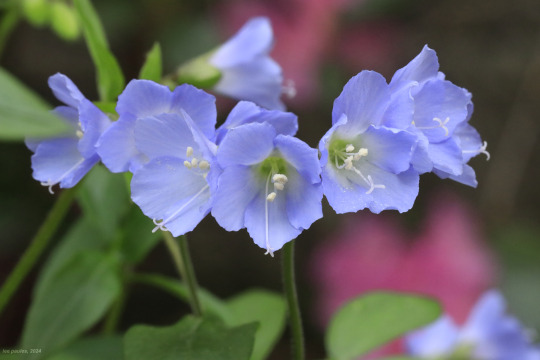









Update on the native wildflower shade garden . . .
Since my last post about the sharp-lobed hepatica several weeks ago, the wildflowers in the shade garden have made a significant push. All of the live plants I put in the ground last fall have made it through the winter, and many of the seeds I planted have germinated and sprouted. Quick survey:
Top: the spreading Jacob's ladder (Polemonium reptans) is mounding beautifully and positively dripping with violet-blue, bell-shaped flowers. The plant lures many pollinators, including bees, flies, butterflies, moths, and beetles. And that foliage is so lush and green . . .
Next one: woodland stonecrop (Sedum ternatum) has established itself in the nooks and crannies of one of my rock features and is getting ready to bloom.
Next two: although the sharp-lobed hepatica (Hepatica acutiloba) has nearly finished blooming, the real joy starts for me when the leathery, thrice-lobed leaves with their often deeply-variegated patterns begin to unfold. This is flat-out one of the most unique and gorgeous wildflowers of North America.
Next one: creeping woodland phlox (Phlox stolonifera) makes for an enchanting ground cover and will spread quite rapidly in the right conditions. I have strong feelings for all the native phlox species, but this one has stolen my heart. It's native to a narrow strip of the Appalachian Mountains from Georgia to Pennsylvania. In the spring around here, it absolutely lights up streambanks with its dainty pink to rose-colored flowers.
Next one: dwarf-crested iris (Iris cristata) is another lovely groundcover but beware - it spreads like wildfire. The lavender and yellow to orange-crested flowers are a treasure to behold from late April to early May. And its arrow-like foliage provides much-needed contrast in the garden.
Next: among the seeds I planted, the yellow pimpernel (Taenidia integerrima) is making the strongest push. The plant produces yellow-flowered umbels similar to golden Alexanders and is a high-value nectar source for many pollinators. It's also the host plant for the black swallowtail and Ozark swallowtail butterflies.
Next two: anyone who visits this Tumblr regularly needs no introduction to heartleaf foamflower (Tiarella cordifolia), my unofficial poster child for Appalachian spring. I simply would not have a native wildflower garden without it. One of my foamflowers is a hybrid (sugar and spice) cultivated for its deeply dissected leaves and intense variegation.
Last (but not least): my eastern red columbine (Aquilegia canadensis) pretty much takes cares of itself - it's one of the best starter wildflowers for beginner gardeners, hardy and undemanding. But man, does it produce loads of beautiful red and yellow, bell-shaped flowers.
#appalachia#west virginia#vandalia#flora#spring#native wildflowers#shade garden#native wildflower garden#spreading jacob's ladder#woodland stonecrop#sharp-lobed hepatica#creeping woodland phlox#dwarf-crested iris#yellow pimpernel#heartleaf foamflower#eastern red columbine
42 notes
·
View notes
Text
Seeds Purchased from Stonecrop Gardens, NY
One of the biggest benefits of membership at Stonecrop is access to their amazing seed bank. Members can purchase rare seeds for $1 a pack. These are plants that are sometimes extremely difficult to find at nurseries and that work perfectly for my area. Here is a list of what I purchased from them...some I've already begun.
The seed collection got suddenly a lot more interesting.
Rarium: Centaurea macrocephala
Rarium: Digitalis parviflora
Rarium: Echinops exaltatus
Rarium: Hosta sieboldiana var. elegans
Rarium: Polygonatum giganteum
Rarium: Salvia coccinea 'Brenthu
Seminum: Acmella oleraceae
Seminum: Actaea japonica (syn. Cimicifuga japonica)
Seminum: Actaea racemosa (syn. Cimicifuga racemosa)
Seminum: Actaea simplex 'Brunette' (syn. Cimicifuga ramosa 'Brunette'
Seminum: Agastache foeniculum 'Alba'
Seminum: Allium angulosum
Seminum: Allium tuberosum
Seminum: Amaranthus hybridus var. erythrostachys
Seminum: Ammi visnaga
Seminum: Anemone virginiana
Seminum: Anethum graveolens
Seminum: Angelica gigas
Seminum: Anthriscus sylvestris 'Raven's Wing'
Seminum: Aster tataricus
Seminum: Astilboides tabularis (syn. Rodgersia tabularis)
Seminum: Astrantia major
Seminum: Calendula officinalis
Seminum: Campanula takesimana 'Alba'
Seminum: Cuphea viscosissima
Seminum: Cynoglossum amabile ‘Firmament’
Seminum: Emilia coccinea
Seminum: Helleborus orientalis
Seminum: Ipomoea lobata (syn. Mina lobata)
Seminum: Monarda punctata
Seminum: Nigella damascena 'Miss Jekyll Blue'
Seminum: Papaver somniferum Mix
Seminum: Salvia farinacea
Seminum: Verbena bonariensis

Anemone virginiana. Interesting thing about this plant is that for years I've pulled it thinking it was a weed. On the years that I forgot to pull it, I was like, man that is pretty! So I now leave it alone. It's drought tolerant and the flowers are loved by pollinators. I'll be planting some more from seed as well.

Anethum graveolens - Dill
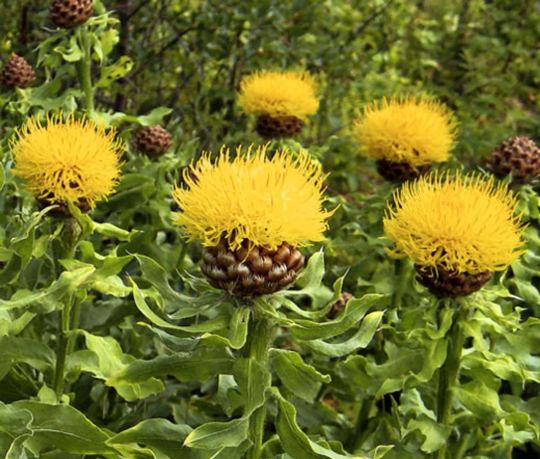
Centaurea macrocephala - Started Seeds 5/3/2024 - This plant is too cool for school!
Category: Rarium | Sub-Category: Perennials for Sun
Scientific Name (Genus/Species): Centaurea macrocephala
Family: (Asteraceae)
(P) to 3′. Great Golden Knapweed. Caucasus. A large, leafy, robust plant bearing sturdy stems topped with incredible, rich golden yellow, hemispherical, thistle-like blooms. The fringed, rusty brown coloured involucre of bracts is very prominent and persists. Midsummer. Makes excellent dried cut flowers. Sun. 3, D & T2

Digitalis parviflora - Started seeds 5/3/2024 - Really different foxglove. Love it.
Category: Rarium | Sub-Category: Perennials for Sun
Scientific Name (Genus/Species): Digitalis parviflora
Family: (Plantaginaceae)
(P) to 2′. Spanish Foxglove. This is a true perennial species of Foxglove, native to the mountains of northern Spain. Plants form a rosette of dark, deeply veined, green leaves bearing in early summer, tightly packed spikes of small, rusty orange-red to chocolate brown flowers on stiff, leafy, upright stems. Eye-catching. Well-drained soil. Sun. 4 & T2
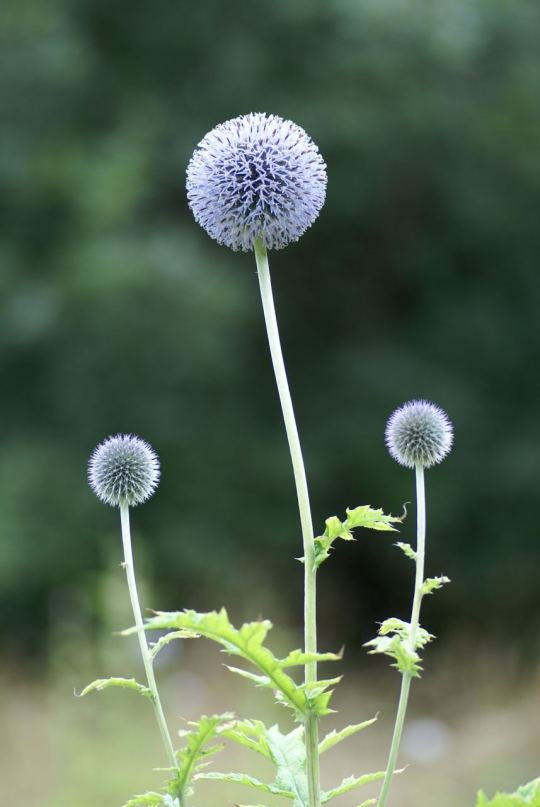
Echinops exaltatus
Category: Rarium | Sub-Category: Perennials for Sun
Scientific Name (Genus/Species): Echinops exaltatus
Family: (Asteraceae)
(P) to 6′. Tall Globe Thistle. Eastern Europe to Russia. Globular flowerheads composed of numerous, tiny, pale blue florets. Flowerheads to 2-½ inches in diameter stand tall on sturdy, downy-white stems and mature into dense, prickly seedheads. The bold, greyish green, thistle-like foliage forms an impressive clump. This summer-to-fall bloomer is a magnet for bees, hoverflies and butterflies. Sun. 4 & T2
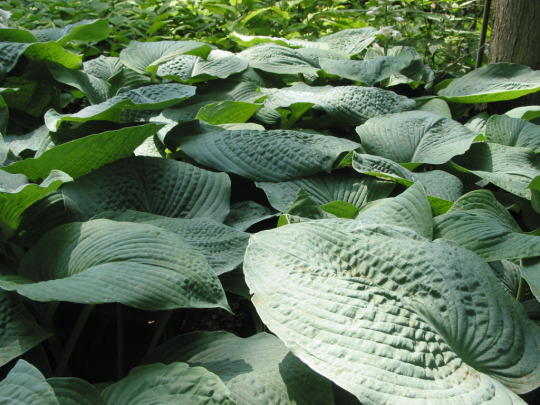
Hosta sieboldiana var. elegans
Category: Rarium | Sub-Category: Woodland
Scientific Name (Genus/Species): Hosta sieboldiana var. elegans
Family: (Asparagaceae)
(P) to 3′. “…most sumptuous of all the Hostas.” (GST**). Huge, broad, glaucous, heavily textured, bluish green leaves form magnificent, stately clumps that add accent and poise to the woodland garden. The pale lilac-white flowers appear in early to midsummer, though they barely emerge from beneath the foliage. 3 & T3, then it may need 40º for 2-3 months.
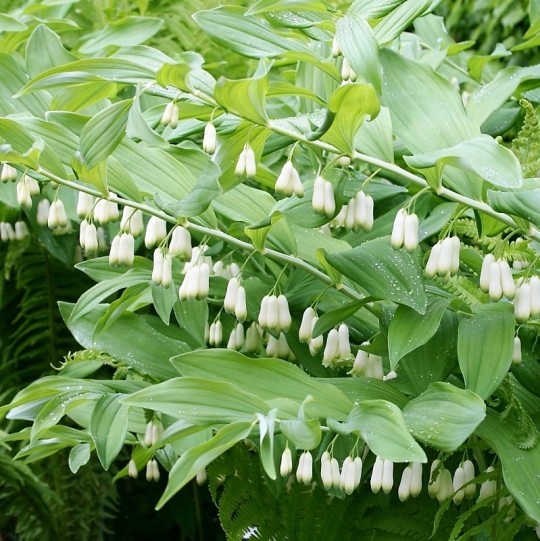
Polygonatum giganteum - Started 5/3/24
Category: Rarium | Sub-Category: Woodland
Scientific Name (Genus/Species): Polygonatum giganteum
Family: (Asparagaceae)
(P) to 7′. Giant Solomon’s Seal. Statuesque and unmistakable. This spectacular giant is similar to Polygonatum biflorum in everything but size. Bell-shaped, greenish white, tubular flowers hang from the tall arching stems in early summer with the dark blue berries following in fall. Moist soil. Shade/partial shade. 3 & 6
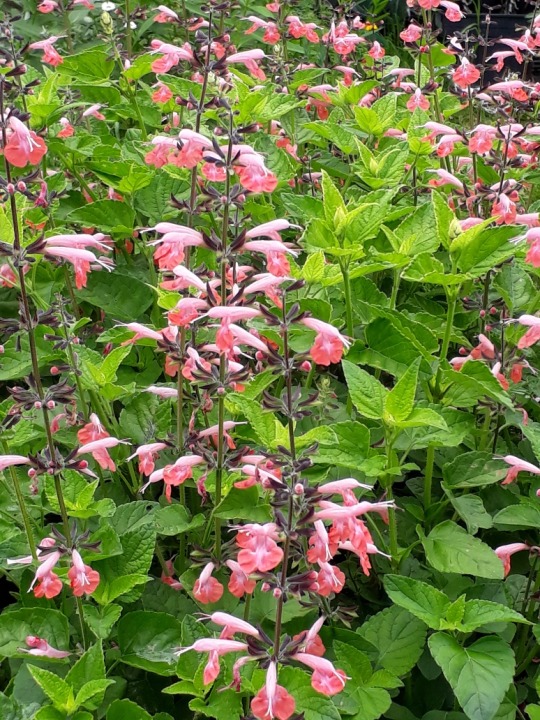
Salvia coccinea 'Brenthurst'
Category: Rarium | Sub-Category: Annuals for Sun
Scientific Name (Genus/Species): Salvia coccinea 'Brenthurst'
Family: Lamiaceae
(A/TP) to 2.5′. A cool-coloured cousin of the red bedding Salvia with numerous spikes of bicoloured, lipped blooms. The pale whitish pink upper hoods and three lobed, deeper pink lower lips contrast nicely against the dark tinted calyces and stems. Blooms late summer and lasts until frost. Sun. 4 & T2
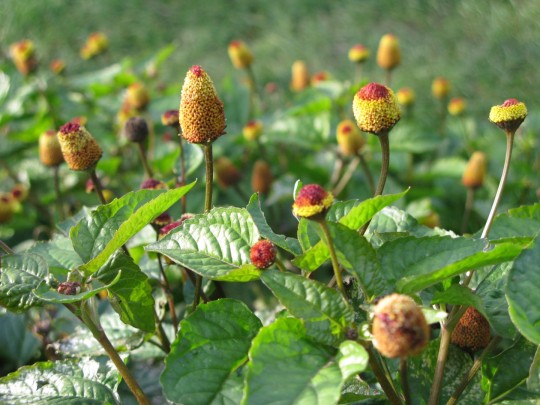
Acmella oleraceae - Toothache Plant
Category: Seminum | Sub-Category: Annuals for Sun
Scientific Name (Genus/Species): Acmella oleraceae
Family: (Asteraceae)
(A) to 10″. Toothache Plant. South America. A profusion of rounded, orange-yellow disc florets with brownish red centres resemble eyeballs. Creeping, bronze-green foliage has numbing properties when chewed, hence the common name. Easy to grow. Very unusual and fun; a “must have”. Summer blooming. Sun. 3 & 6
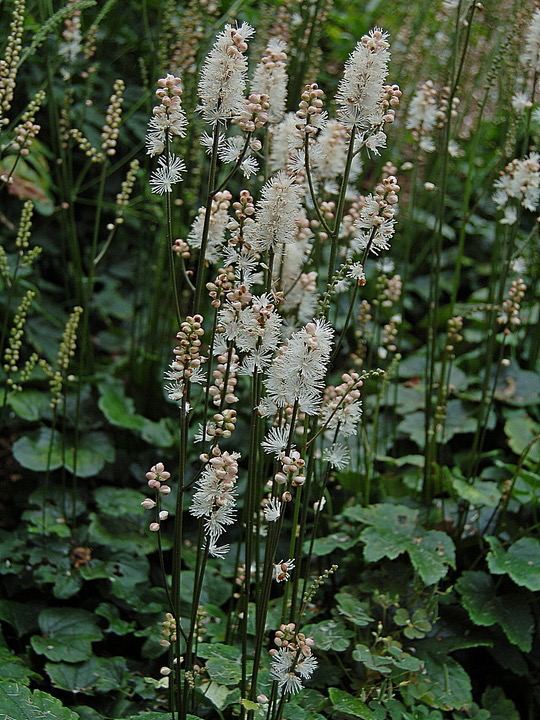
Actaea japonica (syn. Cimicifuga japonica) - snakeroot
Category: Rarium | Sub-Category: Woodland
Scientific Name (Genus/Species): Actaea japonica var. acerina (syn. Cimicifuga japonica var. acerina)
Family: (Ranunculaceae)
(P) to 3′. A Japanese native with handsome maple-like foliage that has long, pointed lobes. Slender branched spikes of white, tufted flowers bloom in September and October. Moist soil. Sun/partial shade. 3 & 6A

Actaea racemosa (syn. Cimicifuga racemosa)
Category: Seminum | Sub-Category: Woodland
Scientific Name (Genus/Species): Actaea racemosa (syn. Cimicifuga racemosa)
Family: (Ranunculaceae)
(P) to 6′. Early Snakeroot, Black Cohosh. An eastern North American native with branched wands of white, bottlebrush flowers. Blooms prolifically in June. Light green, divided foliage remains at three feet tall. Partial shade. 3 & 6A
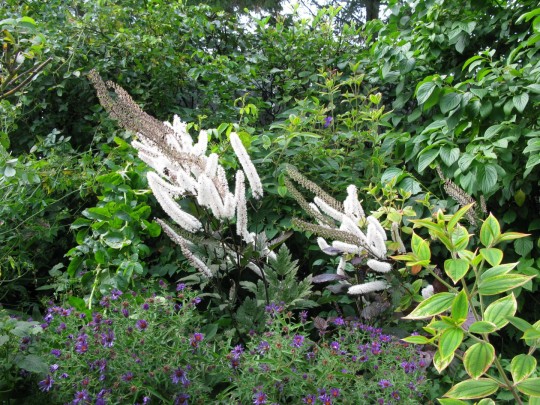
Actaea simplex 'Brunette' (syn. Cimicifuga ramosa 'Brunette')
Category: Seminum | Sub-Category: Woodland
Scientific Name (Genus/Species): Actaea simplex 'Brunette' (syn. Cimicifuga ramosa 'Brunette')
Family: (Ranunculaceae)
(P) to 6′. One of the darkest leaved Cimicifugas. Stems are a rich purplish brown with pure white, upright, fragrant flower spikes in September. Not all seedlings will be as dark as ‘Brunette’, but definitely worth a try. Partial shade. 3 & 6A

Agastache foeniculum 'Alba'
Category: Seminum | Sub-Category: Perennials for Sun
Scientific Name (Genus/Species): Agastache foeniculum 'Alba'
Family: Lamiaceae
Short-lived perennial to 3.5′. White Anise Hyssop. A white cultivar of the above. Sun/partial shade. 4 & T2
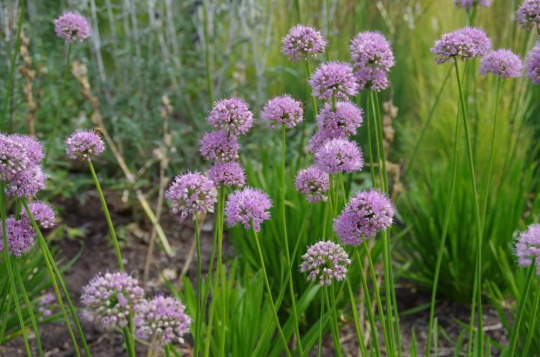
Allium angulosum - mouse garlic
Category: Seminum | Sub-Category: Bulbs
Scientific Name (Genus/Species): Allium angulosum
Family: (Alliaceae)
Hardy bulb to 16″. Mouse Garlic. Europe. Loose heads formed by multiple, cup-shaped flowers of pale purple. Blooms June to August. Sun. 3 & 6
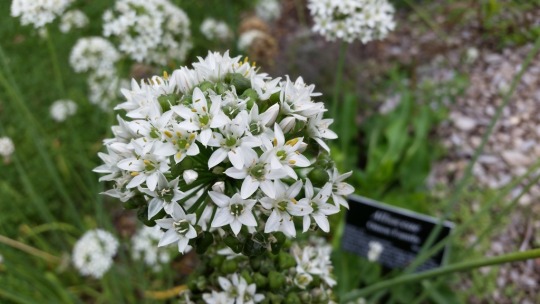
Allium tuberosum - this already grows wild here
Category: Seminum | Sub-Category: Bulbs
Scientific Name (Genus/Species): Allium tuberosum
Family: (Alliaceae)
Hardy bulb to 18″. Garlic Chives. Southeast Asia. Spherical, white blooms freshen the flower garden throughout August. Sun/partial shade. 3 & 6
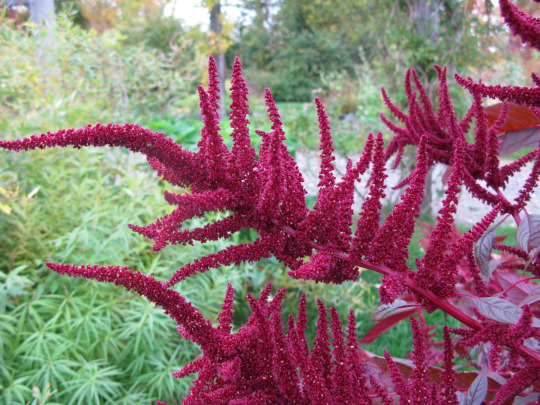
Amaranthus hybridus var. erythrostachys
Category: Seminum | Sub-Category: Annuals for Sun
Scientific Name (Genus/Species): Amaranthus hybridus var. erythrostachys
Family: (Amaranthaceae)
(A) to 5′. Peruvian Tassel Flower. Many branched panicles of crimson, tassel-like flowers accentuated by the deep maroon foliage of this plant, creates drama in the border. Sun. 3 & T3
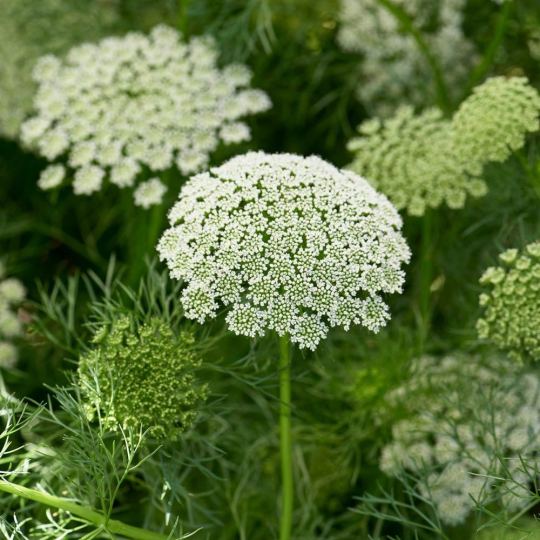
Ammi visnaga - Started Seeds 5/3/2024
Category: Seminum | Sub-Category: Annuals for Sun
Scientific Name (Genus/Species): Ammi visnaga
Family: (Apiaceae)
(A) to 3′. Khella, Toothpick Plant. Egypt. Grown since antiquity for medicinal purposes. This sophisticated Queen Anne’s Lace relative produces masses of feathery, delicate, aromatic foliage topped with wide, compound, flat umbels of tiny, greenish-white flowers. An excellent and unusual filler; most desirable for cut flower displays. Well-drained soil. Sun. 3 & T1

Angelica gigas - Started seeds 5/3/2024
Category: Seminum | Sub-Category: Perennials for Sun
Scientific Name (Genus/Species): Angelica gigas
Family: (Apiaceae)
(B/P) to 5′. This terrific Barry Yinger introduction from Korea and Japan is a stunner. Dramatic, deep maroon, spherical flowerheads emerge from red-flushed, bulbous, leafy sheaths above glossy green, dissected foliage. The afternoon sun intensifies the colour and lends this plant another dimension. Please note, insects, especially hornets, also find it irresistible. Sun/partial shade. 3 & 6
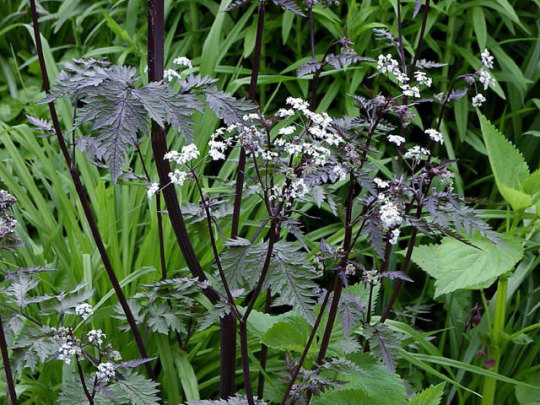
Anthriscus sylvestris 'Raven's Wing'
Category: Seminum | Sub-Category: Perennials for Sun
Scientific Name (Genus/Species): Anthriscus sylvestris 'Raven's Wing'
Family: (Apiaceae)
(B/P) to 5′. Lacey compound umbels of tiny, five-petalled, creamy white flowers, reminiscent of Queen Anne’s Lace, float on hollow, dark stems above fern-like, dusky purple-coloured foliage. Long bloomer that provides an airy elegance to the border. Always admired in our Flower Garden. Self-seeds gently. Sun/partial shade. 3 & 6
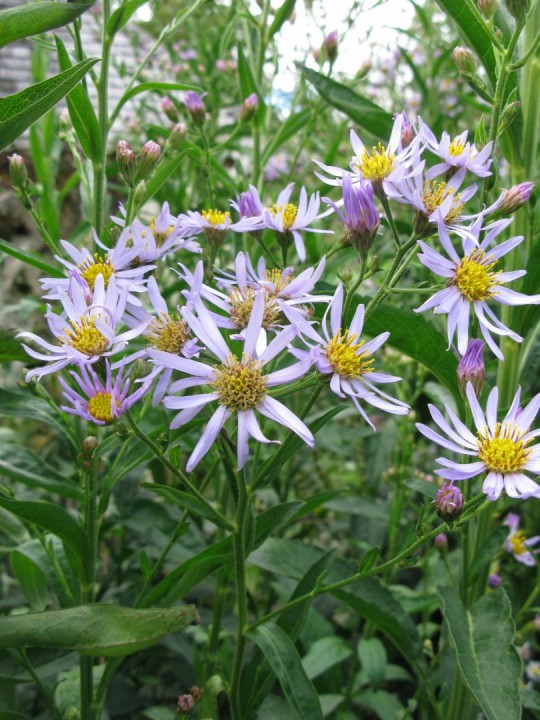
Aster tataricus - this is already thriving in the garden
Category: Seminum | Sub-Category: Perennials for Sun
Scientific Name (Genus/Species): Aster tataricus
Family: (Asteraceae)
(P) to 7′. Tatarian Aster. Siberia. Tall, long-blooming Aster with glorious, loose sprays of bold, lilac-blue daisies with yellow centres. Dense clusters of wide, lance-shaped leaves. Tough, durable plant that will thrive in a variety of conditions. No staking needed, blooms late – September and October and well worth the wait. Sun/partial shade. 3 & 6 & Δ

Astilboides tabularis (syn. Rodgersia tabularis) - Planted some last year, started a bunch of seeds - we'll see. 5/3/2024
Category: Seminum | Sub-Category: Woodland
Scientific Name (Genus/Species): Astilboides tabularis (syn. Rodgersia tabularis)
Family: (Saxifragaceae)
(P) to 4′. William Robinson described it best, “A bold growing and handsome species with huge peltate leaves and plumes of creamy white flowers.” Leaves reach a height of 2 to 2.5 feet. A superb plant to use as a focal point in the garden. Definitely stimulates conversation. Partial shade. 4 & T2

Astrantia major
Category: Seminum | Sub-Category: Woodland
Scientific Name (Genus/Species): Astrantia major
Family: (Apiaceae)
(P) to 2.5′. Great Masterwort. Central and eastern Europe. No garden should be without this effortless and beautiful plant. Several greenish white, often blushed pink flowerheads each arranged in a dome with a “collar” of bracts. Dense clumps of divided basal foliage. Content in the flower garden or in the woodland. Summer blooming. Great in flower arrangements, too. Sun/partial shade. PC- 4 weeks. 4 & 7 for 4 weeks, then T2

Campanula takesimana
Category: Seminum | Sub-Category: Woodland
Scientific Name (Genus/Species): Campanula takesimana 'Alba'
Family: (Campanulaceae)
(P) to 2′. Korea. An outstanding white variety of the beautiful Campanula takesimana. Leaves large in basal rosettes. Branched inflorescence of large, pendant bells on nodding stalks. Flowers are pure white with purple spotting within. Blooms July to September. Sun/partial shade. 4 & T2
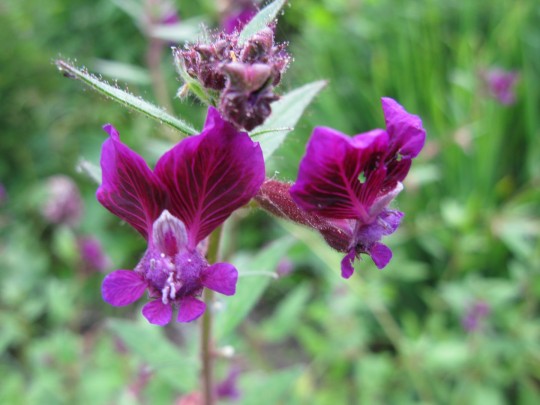
Cuphea viscosissima - Seeds already started 5/3/2024
Category: Seminum | Sub-Category: Annuals for Sun
Scientific Name (Genus/Species): Cuphea viscosissima
Family: (Lythraceae)
(A) to 20″. Blue Waxweed. A North American native and one of our most revered annuals. This non-stop summer bloomer has six deep, magenta-purple petals with the upper two being the longest and a tubular green calyx covered in fine purple hairs. An easy-care annual that requires no deadheading or staking. Very sticky stems trap unsuspecting insects. Self-sows. Sun. 4 & T3

Cynoglossum amabile ‘Firmament’ - chinese forget me not
Category: Seminum | Sub-Category: Annuals for Sun
Scientific Name (Genus/Species): Cynoglossum amabile ‘Firmament’
Family: (Boraginaceae)
(A) to 2.5′. Chinese Forget-me-not. Producing all summer long a profusion of sky-blue, five-petalled flowers. Reminiscent of the Forget-me-not, only taller. Self-sows. Sun. 3, D & T2
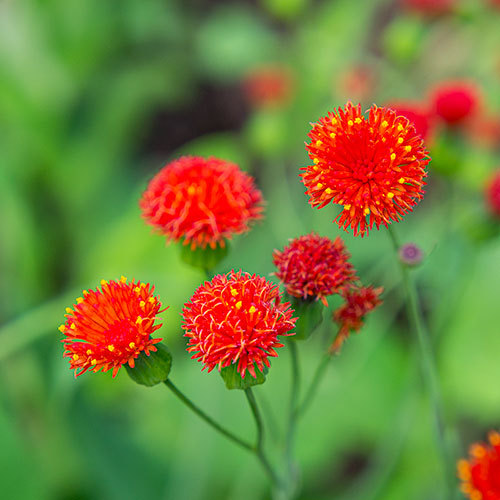
Emilia coccinea
Category: Seminum | Sub-Category: Annuals for Sun
Scientific Name (Genus/Species): Emilia coccinea
Family: (Asteraceae)
(A) to 3′. We love this selection of Tassel Flower. A native of Tropical Africa that produces a profusion of orange to scarlet, thistle-like flowers in terminal corymbs. Best if inter-planted or grown closely together. A real beauty in our Red/Orange/Yellow Bed. Sun.

Helleborus orientalis
Category: Seminum | Sub-Category: Woodland
Scientific Name (Genus/Species): Helleborus orientalis
Family: (Ranunculaceae)
(P) to 2′. Lenten Rose. Europe. Leaves are wide, dentate, glossy and evergreen. Nodding, cup-shaped, pinkish rose, five-petalled flowers have numerous cream stamens. An understated, long-blooming beauty. Early spring. Partial shade. 3 & 72° for 6 weeks, followed by 25-39° for 6-8 weeks.
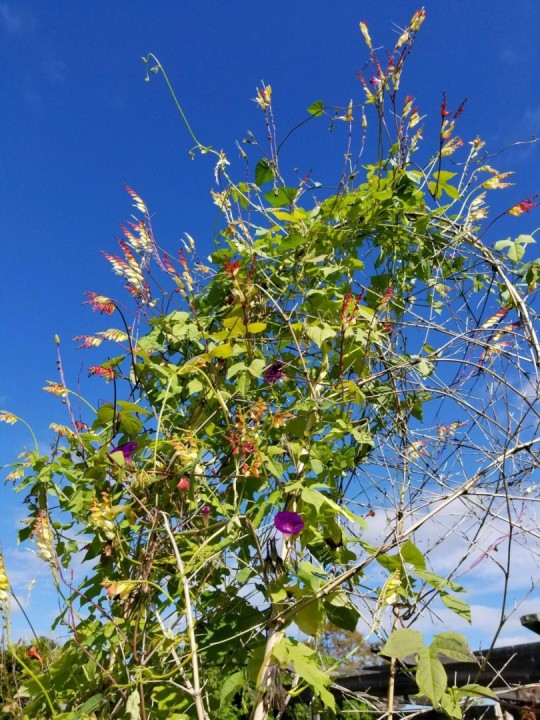
Ipomoea lobata (syn. Mina lobata) spanish flag
Category: Seminum | Sub-Category: Annuals for Sun
Scientific Name (Genus/Species): Ipomoea lobata (syn. Mina lobata)
Family: (Convolvulaceae)
Annual vine to 10′. Spanish Flag or Firecracker Vine. Mexico. An excellent, vigorous, twining vine with attractive, tri-lobed leaves and single-sided, six-inch long racemes of tubular flowers held on slender red stems. The flowers gently arc upward and outward, away from the vine, and mature from red to pale yellow, creating a gradient from the top to the base of the raceme. Blooms freely from mid to late summer until frost. The flowers are highly attractive to hummingbirds, butterflies, and other pollinators. A show-stopper on a tripod. Sun. 1, 2B, 3 & T3

Monarda punctata - Started seeds 5/3/2024
Category: Seminum | Sub-Category: Annuals for Sun
Scientific Name (Genus/Species): Monarda punctata
Family: (Lamiaceae)
(A) to 3′. Horse Mint. Native to the Great Plains of the United States. Dense whorls of pale yellow, hooded flowers spotted with purple-brown. Each whorl is surrounded by large, pink-tipped, green bracts. The narrow, toothed leaves have a grey cast. A very showy plant. Sun. 4 & T1
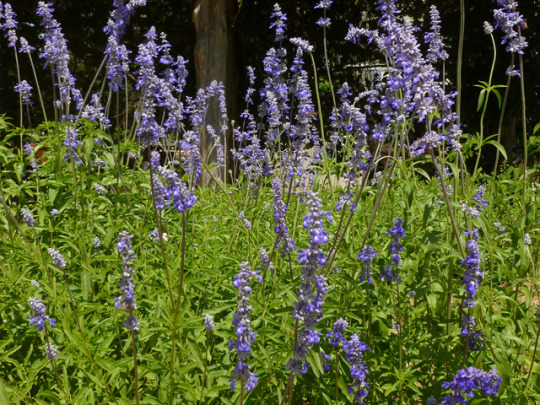
Salvia farinacea
Category: Seminum | Sub-Category: Annuals for Sun
Scientific Name (Genus/Species): Salvia farinacea
Family: (Lamiaceae)
(A) to 3′. Mealy Sage. Native to Texas and Mexico. Tubular, two-lipped, violet-blue flowers are densely congested in whorls along erect stems creating a 4″-8″ spike above the numerous grey-green, lance-shaped leaves. The common name is in reference to the mealy-white (sometimes purple) appearance of the sepals, which are covered with felted hairs. A long-bloomer. Sun/partial shade. 4 & T2
8 notes
·
View notes
Text
OC Associations: Nyana


tagged by @cleric4vampire (thank you sm)
animal: fireflies, deer, stormbirds from horizon zero dawn (lmao)
colours: purple, grey, and gold
month: march
song: everything is free by flock of dimes + sylvan esso and remember my name by mitski
number: 9
day or night: night
plant: honeysuckle, sycamores, orpine (otherwise known as stonecrop or live-forever)
smells: mint, fennel, cardamom, musty old tomes, lingering magic, astarion (according to halsin)
gemstone: jacinth, garnet
season: spring
places: libraries, lively taverns, parks, bookshops, magical marketplaces, lesser known—almost unheard of—historical landmarks, the bath
food: oranges, baguette, a good cheese, butterbuns
astrological sign: ares
element: fire
drink: tea w/ heavy notes of fennel and cardamom, mermaid whiskey, spiced wine
TAGS: @darethshirl @fadedsweater @booplebuns @superfantacywitch @maraudingmalice @makiiato if you haven't already done one of these and want to, i'd love to see your ocs! that goes for anyone else seeing this—tagging any and everyone with oc brainworms.
#oc: nyana#the bath being one of her associated places is the biggest self-insert aspect of this character lmao#bg3
13 notes
·
View notes
Note
this is arrowwood viburnum!


the plant is really pretty and common in landscaping, as the shrub grows really big, and has pretty white flowers (similar to a hydrangea variation i know i think!) that produce dark blue berries
their region is native to europe, america, northern asia, and it can grow well in australia. most of the information i found on it described north america though (such is using google in english maybe hjsdhk)
oh woah this was a perfect plant for me to research :o i read that the name comes from the information that native Americans would use the shoots from the roots as arrow shafts
the berries are edible but most pit anyways, and apparently they dont smell great D:
medicinally, they can be used "as a nerve sedative, anti-spasmodic for asthma and for stomach troubles, colic and hysteria"
arrowwood viburnum is a shrub that flower in may to early june, the fruit matures in autumn, and it loses its leaves in winter
some say the plant smells bad but apparently some say it smells like a green pepper
"Leaves are 2-5" (5-12.5 cm) long, often leathery, and hairy on the veins and the petiole."
Oooo pretty!! And cool!!!!! I kinda recognize the berries, but maybe a similar plant is what I’m thinking of? No idea lol
This is angelina stonecrop!

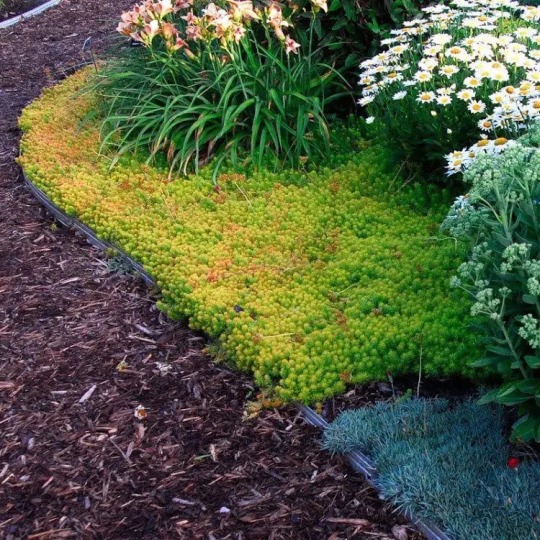

I dont know if its used super often but its a great groundcover. It grows fast and spreads a lot, and is really pretty/‘evergreen’. The foliage turns orange/amber in the winter in northern/colder climates but in milder ones its a chartreuse-yellow year round
Its native to Europe/Turkey, particularly central and western Europe/Britain. I think it can grow anywhere with lots of sun and poor dry soil.
Its a succulent that grows yellow flowers in the summertime
Its also great for a number of reasons: attracts butterflies and hummingbirds, deer resistant and rabbit resistant (good for gardeners i suppose lol), bee friendly, and drought tolerant
The plant is edible, but when eaten in large quantities it gives a stomachache (pro tip dont eat random plants i guess lol)
When planted in containers or in a wall, it develops a cascading habit!!
Doesnt do well with foot traffic tho lol
Its height is 10-15 cm/4-6 inches, and spreads to around 30-60 cm/12-23 inches
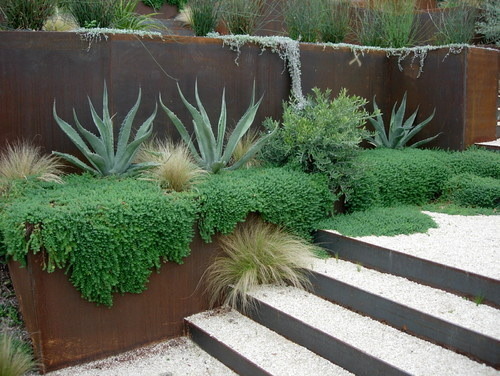
6 notes
·
View notes
Text
Some pics from my garden this year.

Herb garden up on the deck.
Front row (Left->right)- Oregano (Lion tub), Thyme (round pot), Globe Basil (round pot)
Middle Row- Sweet Basil (black tub), Mediterranian Basil (black tub)
Back row- Green Sage (both terra cotta pots), Parsley (black tub), Winter Savoury (black tub)

Rosemary on the upper deck with all the sun
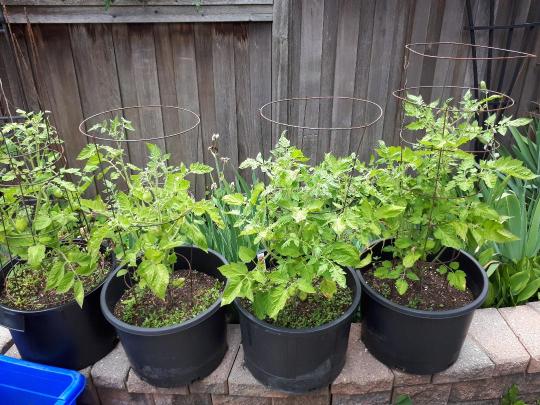

Tomatoes! Roma in the buckets on the wall, and Cherry next to the stairs
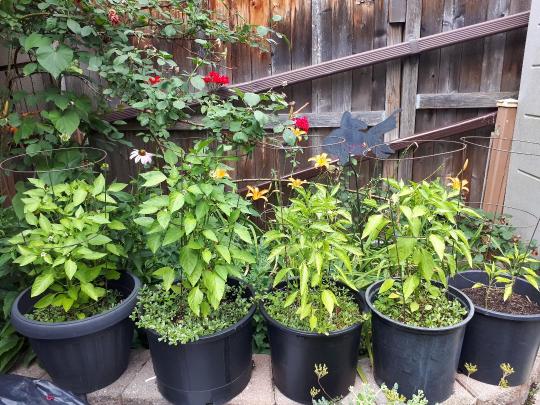

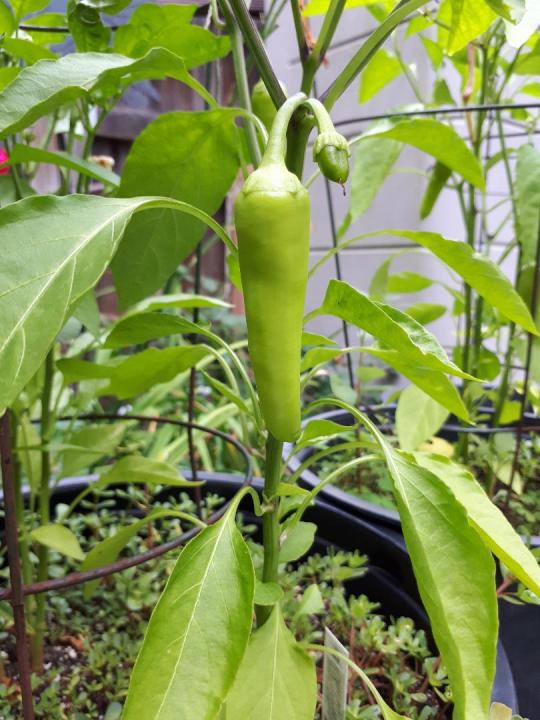
Peppers! Left two are Serrano (dark green), right three are Banana (light green)


Echinacea (pink), Day Lilies (orange), and Roses (red) in the actual bed


Tower of Cucumber Power!!


I got a fire-bowl, but city ordinance says- "No! You'll burn your widdle fingies!" so I have filled it with succulents!
Middle big 'un is Mongolian Stonecrop (Hylotelephium ewersii), left spiky bois are Blue Spruce (sedum reflectum), middle-front rosettes are Hens'n'chicks (Sempervivum tectorum), right is Purple Emperor (Sedum telephium)
#container gardening#small garden#herbs#cucumber#tomato#peppers#echinacea#roses#daylilies#succulents#stonecrop#never-dies#lives-forever#basil family represent#parsley sage rosemary and thyme#plants#garden#my garden
4 notes
·
View notes
Text
Best Plants for Outdoor Gardens: Transform Your Backyard into a Green Oasis
Creating a vibrant outdoor garden requires selecting the right plants that can thrive in your specific climate and garden conditions. Whether you have a sprawling backyard or a compact space, choosing the right plants can enhance the beauty and functionality of your garden. Here’s a guide to some of the best plants for an outdoor garden that are not only easy to care for but also add color, texture, and structure to your outdoor space.
1. Perennials: Long-Lasting Beauty
Perennials are plants that come back year after year, making them ideal for gardeners who want a low-maintenance yet beautiful garden. Some popular perennials for outdoor gardens include:
Lavender (Lavandula): Known for its fragrant blooms and silvery-green foliage, lavender thrives in full sun and well-drained soil. It's also drought-tolerant and attracts pollinators like bees and butterflies.
Coneflower (Echinacea): A hardy plant with vibrant purple, pink, and white petals, coneflowers are drought-tolerant and low-maintenance. They are also great for attracting bees and butterflies.
Hostas: Ideal for shady areas, hostas offer lush green or variegated leaves, adding texture and depth to garden beds.
2. Annuals: Burst of Seasonal Color
Annual plants complete their life cycle in one season, but they provide a spectacular burst of color that can rejuvenate your garden every year.
Marigolds (Tagetes): These bright, cheerful flowers are easy to grow and come in a range of warm colors like yellow, orange, and red. They thrive in sunny spots and are great for deterring pests.
Petunias: Known for their trumpet-shaped blooms, petunias come in a wide variety of colors and patterns. They are great for garden beds, hanging baskets, and containers.
Zinnias: Zinnias are easy to grow, drought-resistant, and come in bright colors that attract pollinators. They bloom from summer to fall, adding continuous color to your garden.
3. Shrubs: Structural Elements
Shrubs add structure and depth to your garden, providing year-round interest and making them great for border planting or as focal points.
Boxwood (Buxus): A classic choice for hedges, boxwood is an evergreen shrub that can be shaped and maintained in various forms. It’s perfect for creating garden borders or topiaries.
Hydrangea: With large, showy flowers, hydrangeas are a favorite for their stunning blooms that can vary in color depending on the soil’s pH level. They do best in part-shade with moist, well-drained soil.
Butterfly Bush (Buddleja): As its name suggests, the butterfly bush attracts pollinators like butterflies and bees. It produces fragrant, spiky flowers in shades of purple, pink, and white.
4. Climbing Plants: Vertical Interest
Climbers are perfect for adding height and vertical interest to your garden, whether it’s on a trellis, fence, or pergola.
Clematis: Known for their large, colorful blooms, clematis are perfect for training on trellises or garden walls. They come in various colors and can bloom throughout spring and summer.
Jasmine: With fragrant white or yellow flowers, jasmine is ideal for climbing up structures and adding a sweet scent to your garden.
Wisteria: This vigorous climber is known for its cascading purple or white flowers. It requires a sturdy support structure but rewards you with beautiful, fragrant blooms in spring.
5. Succulents: Low-Maintenance and Hardy
Succulents are a great choice for gardeners looking for low-maintenance plants that can withstand dry conditions. These plants are known for their fleshy, water-retaining leaves.
Sedum (Stonecrop): With its drought-tolerant nature, sedum is perfect for rock gardens or dry areas. It comes in both ground cover and taller varieties, producing clusters of star-shaped flowers.
Aloe Vera: Not only is aloe vera a beautiful plant with spiky leaves, but it also has medicinal properties. It thrives in dry, sunny conditions and can be grown in the ground or containers.
Echeveria: These rosette-shaped succulents are popular for their striking form and variety of colors. Echeveria is perfect for rock gardens, containers, or as ground cover.
6. Ornamental Grasses: Texture and Movement
Ornamental grasses add texture, movement, and a sense of softness to your garden. They are low-maintenance and can thrive in various conditions.
Fountain Grass (Pennisetum): This grass forms graceful, arching clumps and produces feathery flower spikes in late summer. It’s great for adding texture and contrast to flower beds.
Blue Fescue (Festuca glauca): With its blue-gray foliage, blue fescue is a compact grass that works well in rock gardens or as a border plant. It’s drought-tolerant and low-maintenance.
Maiden Grass (Miscanthus): This tall grass features elegant, feathery plumes that sway in the breeze, adding movement to your garden. It thrives in full sun and well-drained soil.
Final Tips for Planting an Outdoor Garden
Consider your climate: Always select plants that are suited to your local climate and soil conditions. Native plants are often the best choice for low-maintenance gardening.
Plan for sunlight: Observe how much sunlight your garden receives throughout the day and choose plants that thrive in those conditions, whether full sun, partial shade, or full shade.
Mix and match: Combine a variety of plants—perennials, annuals, shrubs, and grasses—for a garden that provides year-round interest and color.
Maintain soil health: Ensure your garden has well-drained, nutrient-rich soil. Consider adding compost or organic matter to improve soil quality.
By selecting a mix of plants that suit your climate, garden space, and maintenance preferences, you can create a flourishing outdoor garden that will bring joy and beauty to your home for years to come.
For More Info:-
Plants For Outdoor Garden
Buy Red Robin Tree Ireland
0 notes
Text
The Beauty of Autumn: A Palette of Seasonal Plants
As summer's warmth begins to wane, nature paints a mesmerizing canvas with the arrival of autumn. Crisp air, falling leaves, and the earthy scent of damp soil bring a sense of calm and rejuvenation. In the world of gardening, it's time to embrace the enchanting palette of seasonal plants that thrive during this cozy and colorful time of year.

Chrysanthemums (Mums): These vibrant, daisy-like blooms come in a variety of warm colors like red, yellow, and orange, making them the quintessential autumn flower. Plant them in your garden or display them in pots to add a pop of color to your outdoor space.
Pansies: Pansies are the perfect autumn companion, with their cheerful faces and shades of purple, gold, and deep red. They can withstand cooler temperatures and even a light frost, ensuring your garden stays lovely well into the season.
Asters: Asters are known for their star-shaped petals and are available in various shades of purple and blue. They attract butterflies and provide a delightful late-season nectar source for these beautiful insects.
Ornamental Grasses: The graceful sway of ornamental grasses in the autumn breeze adds a touch of elegance to your garden. Their golden hues and feathery plumes create a stunning contrast against the changing foliage.
Sedum: Also known as stonecrop, sedum plants offer clusters of small, star-like flowers in shades of pink, red, or white. Their succulent leaves make them exceptionally drought-resistant, perfect for low-maintenance gardening.

Japanese Maples: With their exquisite foliage in shades of deep red, maroon, and orange, Japanese maples are a standout in any garden. Their fiery hues intensify as the temperatures drop, making them a breathtaking addition to your landscape.
Lavender: This aromatic herb not only adds a lovely scent to your garden but also continues to bloom into the autumn months. Lavender's silvery-green foliage and vibrant purple blossoms are a visual and olfactory delight.
Hardy Mums: As their name suggests, hardy mums are built to withstand colder temperatures. Their cheerful blooms and array of autumn colors make them a go-to choice for fall gardening.
Cyclamen: These dainty, heart-shaped flowers are perfect for adding a touch of elegance to your pots and borders. Cyclamen come in shades of pink, red, and white and thrive in the cooler, shadier spots of your garden.
Heuchera (Coral Bells): The vivid foliage of Heuchera comes in a range of autumnal hues, from deep red to copper and bronze. These perennials not only provide color but also attract hummingbirds with their delicate blooms.
Autumn is a time of transition, and these seasonal plants can help you embrace the changing landscape with grace and beauty. Whether you're a seasoned gardener or just beginning, the vibrant colors and hardy nature of these autumn plants will inspire you to savor every moment of this enchanting season.
0 notes
Photo
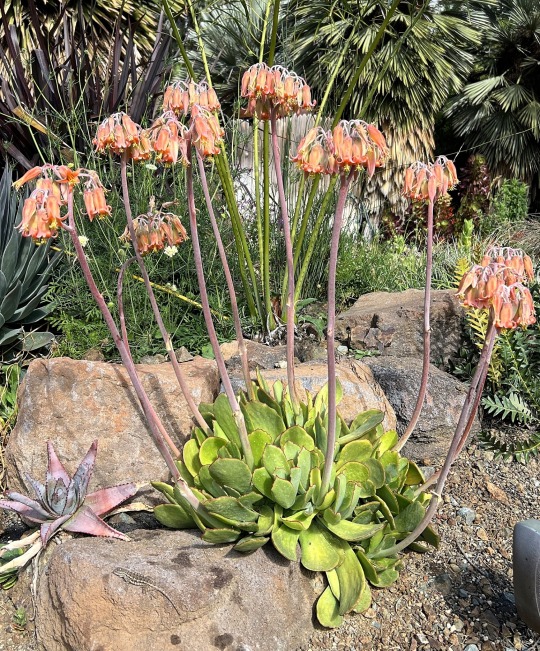

Cotyledon orbiculata
There are multiple species of Cotyledon native to South Africa, but Cotyledon orbiculata is much the most common and widespread, as well as the most variable. Its leaves may be green, gray or white, often with a narrow red margin, and they may be paddle-shaped or round or cylindrical. While its flowers are always pendulous, they may be red, coral or orange. The plant pictured is a form with green leaves edged with red, and pale salmon-colored flowers. The genus Cotyledon is part of the Crassulaceae, or Stonecrop Family.
-Brian
33 notes
·
View notes
Text
hey. hey. everybody suggest names for my plants in the replies while I'm at work
I dont care if we have never spoken to each other I just need names for my plants
#i have#two tree lavenders#a tree rosemary#two carnations one orange one pink#another different type of lavender#a boxwood basil#two rings of sedum#two hens n chicks#an umbrella plant#a pink tabletop hydrangea#another. different sedum (stonecrop orpin)#and a Japanese shield fern#oh and i have some irish moss as well
2 notes
·
View notes
Photo


Numero Uno (eau de parfum)
Carthusia
Woods
A fragrance which both represents and follows the Mediterranean man. The intensity of musk and the spicy tones of rosemary will unleash in you a wave of intense pleasure and give your senses a complete revolution, refreshed by orange and lavender. Numero Uno vividly captures the wild beauty of the island that inspired it.
Top notes: Orange, Bergamot, Eucalyptus
Heart notes: Violet, Patchouli, Ylang ylang, Mugwort, Thyme, Litsea Cubeba
Base notes: Vetiver, Moss, Stonecrop, Myrrh, White musk, Cistus
#carthusia#eau de parfum#woods#orange#bergamot#eucalyptus#violet#patchouli#ylang ylang#mugwort#thyme#litsea cubeba#vetiver#moss#stonecrop#myrrh#White Musk#cistus
0 notes
Text
“Take (Ground) Cover, N°3”
“Take (Ground) Cover, N°3”

View On WordPress
#Aureum#green#ground cover#leaves#macro#macro photography#needles#orange#plants#prickly#red#Sedum reflexum#Sedum reflexum Aureum#spikes#Stonecrop#succulents#yellow
0 notes
Text
Flora, Fauna and Environment of Nan Tathren
I’ve been really enjoying my Flora, Fauna and Environment of Arda series and I wanted to do some smaller locations and ecosystems as well as more larger regions that I constantly go back and add more to. These will include both smaller parts of the areas I’ve done and new ones
(I’ll continue to do larger areas too and I’ll take requests for any and this includes the Barad Eithel request I got awhile back, I’m so sorry for the delay!)
Nan Tathren, “valley of willows”, is a vale in mid Beleriand where the River Sirion met its largest and Southernmost tributary, the river Narog. It was South of the gates of Sirion and north of the Havens. The Power of Ulmo was strong here even after Nirnaeth where the area was roamed by orcs.
In The Book of Lost Tales, it was said that all butterflies came from Nan Tathren and though this was discarded as canon, the flowery meadows of the vale were said to have lots of butterflies.
The climate was likely warm temperate with little snowfall despite seasonal changes. This was due to the influence of Ulmo who shielded the valley from harsher weather. This meant that there was something of a protective sheen around the vale with some notable differences within its borders to the surrounding regions.
The trees of Nan Tathren are not close or crowded together and elf, orc or other creature alike can easily wander through the more forested areas. Weeping willows, musk willows, and white willows as well as common and Engler’s beech trees and common ash make up the highest number of trees in the vale
In the meadows grow a wide variety of wildflowers and herbaceous plants that are home and nutrients to the many butterflies of the valley; the Apollo butterfly which feeds on white stonecrop, swallowtails which feed on rue and fennels, female orange tips with common dogwood violet, small tortoiseshell and common nettle, scarce fritillary and honeysuckle, speckled wood with annual meadow grass, dusky meadow brown, silver studded blue and rockrose, mother or pearl blue and woundwort, and green hairstreak with blue vetch, peacock butterfly with willow, dandelions and danewort, poplar admiral with poplar and aspen, clover and cape broom.
During the nighttime, moths flutter over the fragrant meadows feeding from their various sources; magpie moth with red current, meadow sweet button with meadowsweet, blood vein and sorrel, barred yellow with dog rose, common marbled carpet with strawberry,
There are more of course, this is only a small selection!
Fish are abundant in the crossing of Sirion and Narog. Marbled trout, common minnow, spiny loaches, grayling, asper, and other, stranger creatures that aren’t known to modern earth are in the protection of Ulmo’s power here. As I believe exist throughout Arda (and is supported by Tolkien’s description that ‘all creatures that ever walked the earth and many that did not’) there are species that no longer exist on earth today. Perhaps Paleoparadoxia find safety in the deep waters where the tributary meets Sirion.
Larger animals are rare here and usually only pass through, adding to the feeling and description of the vale as desolate but peaceful. Larger mammals do occasionally enter the valley to drink from one of the many clear pools along the river. Roe and fallow deer and elk cross along one or two of the fords, timber wolves shelter under the willows after an unsuccessful hunt, strange okapi like creatures blend into the trees as they sip from the water.
Smaller mammals do make their home in the valley more permanently as do birds.
Field mice, garden dormouse, flying squirrel, water vole, pine voles Kogaionon, smaller species of gray foxes, Vulpavus, the occasional Rhizosmilodon, tayra, and species of hedgehogs.
Greenish warbler, willow warbler common firecrest, dusky thrush, black and green woodpeckers, spotted nutcracker, common kingfisher, ural owl, and marbled teal being some examples of birds along with a few giant swans that take sanctuary in the reeds of the slower sections of the river,
Spiny newts, brook salamander, midwife toad, agile frog, along with
wood turtle, striped neck terrapin, snake eyed lizard and green meadow snakes.
20 notes
·
View notes
